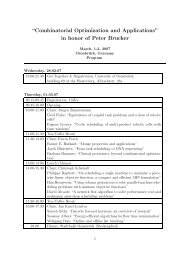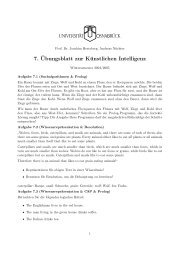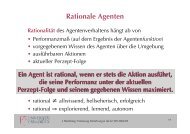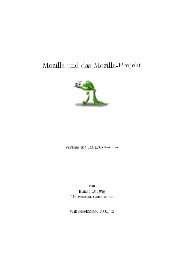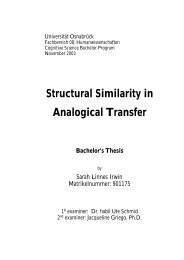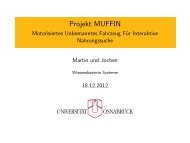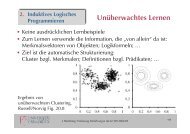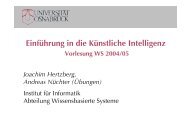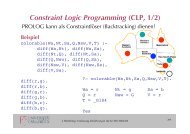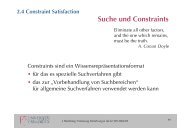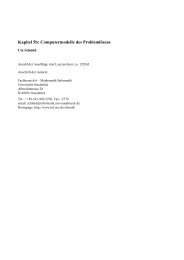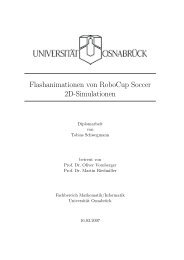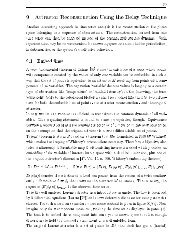Unsupervised Recursive Sequence Processing - Institute of ...
Unsupervised Recursive Sequence Processing - Institute of ...
Unsupervised Recursive Sequence Processing - Institute of ...
Create successful ePaper yourself
Turn your PDF publications into a flip-book with our unique Google optimized e-Paper software.
R N is provided, N denoting the number <strong>of</strong> neurons, which explicitly represents<br />
the contextual map activation <strong>of</strong> all neurons in the previous time step. Thus, the<br />
temporal context is represented in this model in an N-dimensional vector space, N<br />
denoting the number <strong>of</strong> neurons. One can think <strong>of</strong> the context as an explicit storage<br />
<strong>of</strong> the activity pr<strong>of</strong>ile <strong>of</strong> the whole map in the previous time step. More precisely,<br />
distance is recursively computed by<br />
d RecSOM ((s 1 , . . . , s t ), n j ) = η 1 ‖s 1 − w j ‖ 2 + η 2 ‖C RecSOM (s 2 , . . . , s t ) − c j ‖ 2<br />
where η 1 , η 2 > 0.<br />
C RecSOM (s) = (exp(−d RecSOM (s, n 1 )), . . . , exp(−d RecSOM (s, n N )))<br />
constitutes the context. Note that this vector is almost the vector <strong>of</strong> distances <strong>of</strong> all<br />
neurons computed in the previous time step. These are exponentially transformed<br />
to avoid an explosion <strong>of</strong> the values. As before, the above distance can be decomposed<br />
into two parts: the winner computation similar to standard SOM, and, as in<br />
the case <strong>of</strong> RSOM and TKM, a term which assesses the context match. For Rec-<br />
SOM the context match is a comparison <strong>of</strong> the current context when processing<br />
the sequence, i.e. the vector <strong>of</strong> distances <strong>of</strong> the previous time step, and the expected<br />
context c j which is stored at neuron j. That is to say, RecSOM explicitly stores context<br />
vectors for each neuron and compares these context vectors to their expected<br />
contexts during the recursive computation. Since the entire map activation is taken<br />
into account, sequences <strong>of</strong> any given fixed length can be stored, if enough neurons<br />
are provided. Thus, the representation space for context is no longer restricted by<br />
the weight space and its capacity now scales with the number <strong>of</strong> neurons.<br />
For RecSOM, training is done in Hebbian style for both weights and contexts. Denote<br />
by n j0 the winner for sequence entry i, then the weight changes are<br />
△w j = ɛ · h σ (nhd(n j0 , n j )) · (s i − w j )<br />
and the context adaptation is<br />
△c j = ɛ ′ · h σ (nhd(n j0 , n j )) · (C RecSOM (s i+1 , . . . , s t ) − c j )<br />
The latter update rule makes sure that the context vectors <strong>of</strong> the winner neuron<br />
and its neighborhood become more similar to the current context vector C RecSOM ,<br />
which is computed when the sequence is processed. The learning rates are ɛ, ɛ ′ ∈<br />
(0, 1). As demonstrated in [41], this richer representation <strong>of</strong> context allows a better<br />
quantization <strong>of</strong> time series data. In [41], various quantitative measures to evaluate<br />
trained recursive maps are proposed, such as the temporal quantization error and<br />
the specialization <strong>of</strong> neurons. RecSOM turns out to be clearly superior to TKM and<br />
RSOM with respect to these measures in the experiments provided in [41].<br />
8





